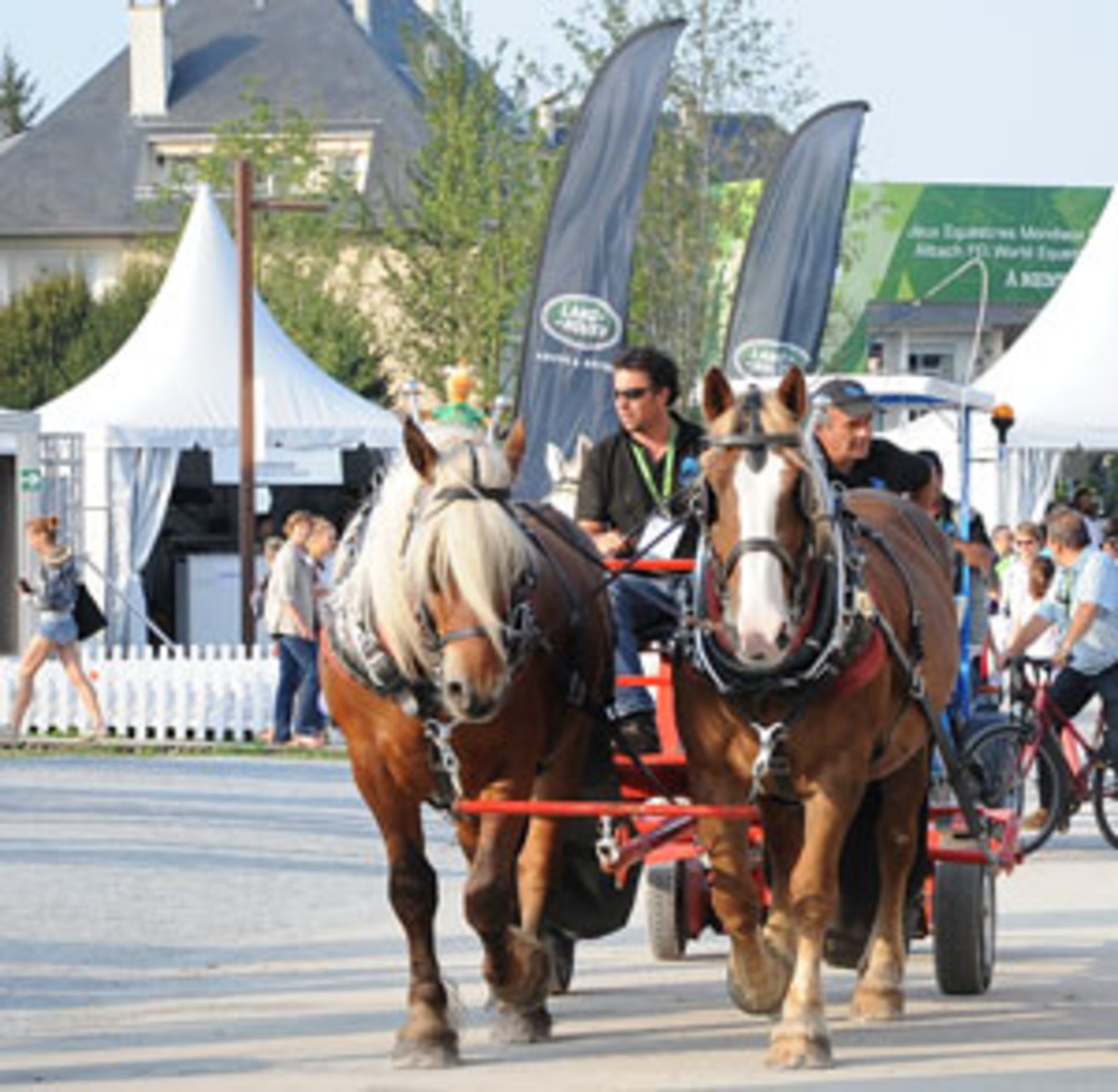September 5, 2014 — “Have fun at the World Equestrian Games! Enjoy the great French food.”
That’s the way people usually responded when they heard I would be at the WEG in Normandy, France.
And my answer to them? Fun — not happening. French food — I’m living on the ubiquitous ham and cheese sandwiches, heavy on the bread, when I can get them. Sleep–in short supply.

What is happening, of course, is great sport. It definitely attracts a crowd. Venues have been full or nearly so, with attendance at 560,000 for the run of the Games.
There is a lot to be said for standing in the aura of Charlotte Dujardin when she performs her magical musical freestyle with Valegro, then talking to her about it face-to-face or being ringside to watch Beezie Madden clinch bronze for the U.S. over a formidable show jumping course. Viewing on line is convenient, but you do lose the atmosphere.
As journalists, of course, we need to be here to speak with the athletes. Generally, though, it is done under very controlled conditions in the “mixed zone,” where competitors are brought for a quick talk after their performances. Not exactly the way to get an exclusive. You operate completely differently than you do at a big show, where the stable is the only no-go area.
So the competition with the best in the world all here is terrific — when you can get to it. Transportation provided by the organizer hasn’t exactly been reliable. I have a list of horror stories. Yesterday, for instance, I decided to try a spectator bus, as opposed to a media bus that runs less frequently.
I asked the driver if he were going to the stadium. Since I don’t speak French, I just said, “Stade d’Ornano?” and he said “Oui.”
The next thing I knew, we were parked in an industrial area and he told passengers to get on another bus. So we did, and sat there, inexplicably, for 10 minutes. The time I thought I’d save, I wasted. When we finally got going, dozens of passengers got on at the next stop, cramming in until there was no room to breathe. It was downright alarming. I won’t be doing that again.
Buses often run on time, but when they don’t, it’s a problem getting from here to there. Good luck if you’re stranded. You can’t just hail a cab; this isn’t New York City.
I have been to every FEI (international equestrian federation) WEG since they began in 1990 in Stockholm, and they have gotten increasingly taxing for those of us who work at these Games, and judging by what’s happening here, for the spectators as well.
The first WEG was great. There were only six sports (two less than we have now with the addition of reining and para-dressage). The venues were in close proximity, so we could walk to everything and public transit enabled us to get to our hotels.
The WEG has ramped up since, and in general, it has been a money-loser. The cost of putting it on is enormous, and it’s also costly for those wishing to attend. Hotels always jack up their prices for the occasion.
I was chatting with Franz Venhaus, who was in charge of the equestrian competition at the 2000 Olympics in Australia, telling him I thought he could have done a great job organizing this WEG, where there have been problems with everything from transport and food to bathroom facilities. Without going into great detail, let me just say that many of the “sanitaires” aren’t so sanitary.
My most interesting experience involved a seedy wooden shed at the cross-country venue, where “flushing” meant throwing in wood chips. In the main stadium, I was told there was a lack of decent facilities for women, since it is a football (soccer) stadium. Soccer fans don’t go to the bathroom? Women don’t attend?
At any rate, Franz was skeptical about my observation on his ability to straighten things out here, pointing out that organizing an Olympics is different than a WEG, because there is so much more sponsor support.
But the WEG has taken on proportions of a mini-Olympics for horses. The original idea was to let people get a taste of disciplines other than their own. It worked brilliantly in Stockholm and at Aachen in 2006, where again, everything was on the same piece of property or adjacent to it.
The Aachen showgrounds will be hosting a mini-WEG style multi-discipline European Championships next year, but when I spoke to the facility’s show director, Frank Kemperman, he said he had no interest in running a WEG every four years (as some have suggested). He also declined to discuss the organization here, because he is a member of the FEI bureau.
Getting around wasn’t bad in Kentucky 2010, though the Kentucky Horse Park is spread out, and while ideally there could have been more intra-park transportation available, it usually was possible to get from Point A to Point B without too much strain. That made it possible for me to cover two disciplines on the same day rather easily.
But here, there are schedule conflicts (the afternoon of the driving marathon tomorrow, for instance, when the best competitors would go, is at the racetrack at the same time as individual show jumping to make the cut for the all-important Final Four is at the d’Ornano Stadium.)
Although there are several venues along a bus route in the city, we also had two far-flung venues. Endurance was more than an hour away, and eventing dressage and cross-country in another direction about 90 minutes from Caen — except on cross-country day.
I sat in traffic on the bus for three hours each way. Many people gave up and turned around, as tiny roads around the eventing venue clogged up with vehicles. And the organizers couldn’t figure this out in advance? They knew it, but they just didn’t have an effective plan in place to handle traffic. The lack of toilets and food at eventing resulted in long lines and plenty of grumbling, and there was little effort to coordinate passage through the cross-country course, as mobs surged from one side to another on slippery, muddy ground.
All around, there has been a lack of strategic planning and communication. As one official from a team said to me, “the left hand doesn’t know what the right hand is doing.”
Ask for an answer to a question, if you can find someone who speaks good enough English, and they’re apt to say one thing, while someone else says something else. So maybe you take an average of the answers and hope for the best? Volunteers, in many cases, have not been properly trained and will give you an answer just to say something, right or wrong.
There are vendor stands, entertainment and dining in the Games Village, with an emphasis on Normandy products. Oddly, it closed on the non-competition day last Monday, when journalists and others who had too many commitments to visit would have liked to spend a few hours there.

It’s about a 20-minute walk from the main stadium. Buses do stop there, but to go from the stadium on lunch break to the village takes time. Meanwhile, the stadium closes at lunch time, but the food that is available during the competition is substandard anyway.
The arrangement has been a bonanza for a wonderful bakery across from the stadium. I wish I had bought stock in it before the Games started. There usually is a line of 60 to 70 people there at any time over a period of hours, as they are shuttled in quite fast (the staff is very efficient) and head out with their quiches or baguettes.
I wonder how much the organizers here learned from the problems in Kentucky, though I’ve heard people say that the oft-criticized Kentucky WEG would have been praised to the heavens if it had taken place following Normandy.
So what’s the solution? A number of people think the WEG has reached its sell-by date. Bromont, Quebec, Canada, which is hosting 2018, had to wait for its bid to be awarded as the FEI sought more candidates. Finally, Bromont was the only contender left standing, so it (apparently reluctantly) got the nod.

Bromont representatives are on hand here to survey the operations. I hope they learn what not to do. Everything will be on one very large piece of property in Bromont, which hosted the 1976 Olympic equestrian events, but hotels are scarce in the area, so transportation for those who don’t have cars will be important.
A solution going forward could involve grouping several world championships together in sort of a mini-festival. At the European Championships in Denmark last year, for instance, show jumping, dressage and para-dressage were all at the same facility.
Others I respect have suggested offering only the Olympic disciplines and perhaps four-in-hand driving, with other disciplines as brief exhibition only.
In 1986, the last major world championships year before the WEG, I went to Australia for eventing, Aachen for show jumping, England for four-in-hand driving and Canada for dressage. World Championships always were held separately until the 1990 WEG. Those trips were expensive and time consuming for anyone like me who wanted to see more than one, but striking a happy medium between that and the WEG would seem like a good choice.
I have to say that this week has gone better than last week. It’s the learn-as-you-go program. One wit suggested that by the time of the WEG’s third week, it will be fine. Except that there is no third week.
And that’s another problem with the WEG. Since it has always been a one-off, just as an organizing committee is getting things right and learning what to do, it will never have a chance to do it again.
I think the reverberations from Normandy should prompt a rethink and hopefully, a better way of doing things can be worked out. The FEI must be more hands-on supervising and getting real answers about how things will work during the Games. Otherwise, with live streaming available, many more people may choose to forego the atmosphere, the cost and the inconvenience, choosing instead to watch from the comfort of their living rooms.
Tonight I went to vaulting and will be posting photos from there on facebook.com/equisearch. There were some amazing performances. Tomorrow evening, look for my postcard from show jumping.
Until then,











